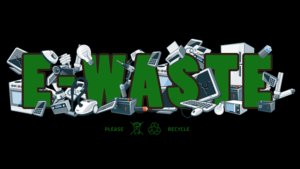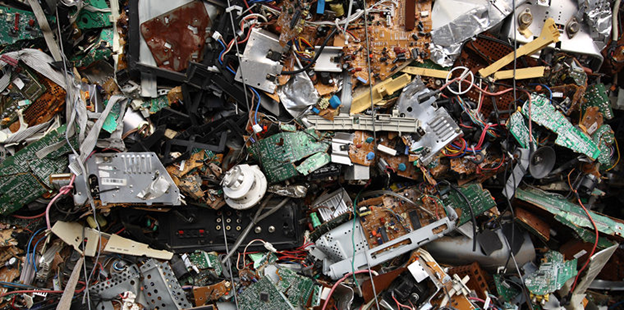
A man met his counterpart, he decided to make them in mounds, for he seemed to be more efficacious than the man himself. How manipulative of him? Don’t we all think so? However, we take pleasure when all the clothes are washed by the washing machine when we hear the alarm of the microwave and the taste of a cold drink from the refrigerator. However, as much as we don’t care about the general non-biodegradable waste something more imminent but which may seem innocuous is dawning upon us. The era of Electronic- Waste, or ‘E’- Waste. To define E-waste using jargon: According to the WhatIs dictionary, E-waste is any refuse created by discarded electronic devices and components as well as substances involved in their manufacture or use. Used electronics, destined for reuse, disposal, or salvaging also come into the category of waste.
E-waste is extremely hazardous. It consists of toxic chemicals, which are not decipherable with the naked eye, and hence not much importance is given thereof. Lead, Cadmium, Beryllium, brominate flame retardants like PBDEs, PBBs are the prominent promiscuous emissions from the manufacturing process. Examples of common appliances are CPUs whose life is over, televisions, stereos, refrigerators, ovens, etc.
How is E-Waste generated?
It requires a very simple technique to generate E-Waste. Just use the simplest and impure of techniques to build a product. Earlier, cathode ray tubes were the major cause of concern. Now it is lead, copper, and mercury. According to statistics, the major constituents are Iron and Steel followed by plastics. The sector-wise contribution to E-waste in India is as follows- Computer devices account for nearly 70% of E-waste, with the contribution of telecom sector being 12%, medical equipment being 8%, and electric equipment being 7% of the annual E-waste production.
How is E-waste processed?
The E-waste is recycled in a step-wise process. The processes are tedious, labor-intensive and time-consuming.
Firstly, all the scrap and metal are collected and transported to the recycling paths. After they arrive at the plant, they are sorted to useful, recyclable elements and non- recyclable elements. Shredding allows an efficient reduction of the size of the components where the size can be reduced to nearly 100mm. Hence, they are shredded before the plastic is separated from the internal circuitry.
After sorting, one can decide if the material is fit for further recycling or if it can be reused in the present state itself. The magnetic separation involves segregating the iron scrap from the plastic. Essentially all the iron-based materials are separated in this process. This steel is plugged into the recycling process for steel, from which they come out as- “ Recycled Steel”.
Further, the other metals like Lead, Copper from the circuit boards are separated using pyrometallurgical processes. Precious metals like Gold, Silver are extracted by hydrometallurgical processes. Bioleaching, where microorganisms are used to convert the metals in solid form to dissolved form. Here metals like Nickel, Aluminium, Zinc Copper and also Lithium from the Lithium-ion batteries are extracted using different kind of bacteria like Acidithiobacillusferrooxidans and Acidithiobacillusthiooxidans. However, these processes only account for the metals. Sadly, the plastic still remains. With water separation technology, the glass is separated from the plastic. After separation, all the materials except plastic is sent out as recycled waste, fit for use. They are used to produce some more E-waste to be more precise.
But before recycling the scrap is still an active virulent creature capable of causing crucial health complications to humans and the environment.
E-waste situation in India
India has become the fifth largest producer of E-waste. According to the reports, it produces 2 million tonnes of E-waste every year. In India, Maharashtra leads the show.
When E-waste generation hit sky-high levels, the governments of different countries and the United Nations came up with rules and regulations to control the effects. When it comes to India, the following are the norms for regulating the E-waste-
- The Hazardous Wastes (Management and Handling) Amendment Rules, 2003;
- Guidelines for Environmentally Sound Management of E-waste, 2008; and
- The E-waste (Management and Handling) Rules, 2011.
Each of the guidelines has their own terms and conditions that specify categories of E-waste, methods of disposal, harmful effects of the scrap and treatment of E-waste. Under the new rules, producers will have to issue consumers with information on disposing of equipment after use to prevent E-waste from being dropped in domestic waste and must make the public aware of the hazardous components present.

The Extended Producer Responsibility( EPR) is the most crucial provision amongst the E-waste regulation norms in India. According to EPR, manufacturers are responsible for the post-consumer waste of their respective EEE products. The E-waste rules were notified in 2011 and came into effect in 2012. But is this the right way? Often we find rule breakers in the fray, who fail to act upon these rules. In India, it is way too often. Turning a blind eye to the rules in place, producers and manufacturers continue to exploit the environment and the workers. One such incident where the government took a stringent action is in the year 2015, where the central zone of National Green Tribunal came down heavily on the producers and the manufacturers, ordering them to collect all the discarded electronic goods.
Disposal of E-waste in India
India imports 50,000 tonnes of E-waste every year. But the people who handle it are not aware of the harmful effects of the same. Often, rag pickers find the scrap metal in the dump yards and sell it to scrap dealers. There is no proper regulation of E-waste in India. Producers usually sell it to the uneducated scrap dealers, who do not make an informed decision about it.
In some instances, the metal again finds its way back to the dump yard. Confining it to the ground causes seepage of Lead, Copper into the groundwater which causes pollution. When consumed a person suffers from lead poisoning which is a chronic disorder, diagnosable only after accumulation. Adding to the chaos is soil pollution by the aforementioned heavy metals. They enter the food chain through the plants which consume them. The very difficulty in the problem is that the symptoms cannot be detected in the early stages. The symptoms show up only when the poison is exaggeratingly high in concentration. The cliché air pollution comes into the picture, during production as well as incineration of E-waste.

Having said the implications of the Technology boom, it solely lies in the hands on the individual’s discretion to make sure he knows the hazards of the little daredevil that sits on his palm all the time. It is just a sand on a beach. But E-waste generation is more than all the particles present in all the beaches of the world put together. Conscious efforts need to be taken to increase awareness in people, producers, and dealers.
Hoping mother earth would not stop casting her charm on us!



















